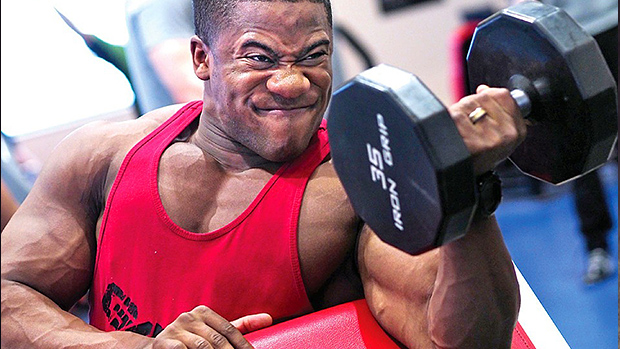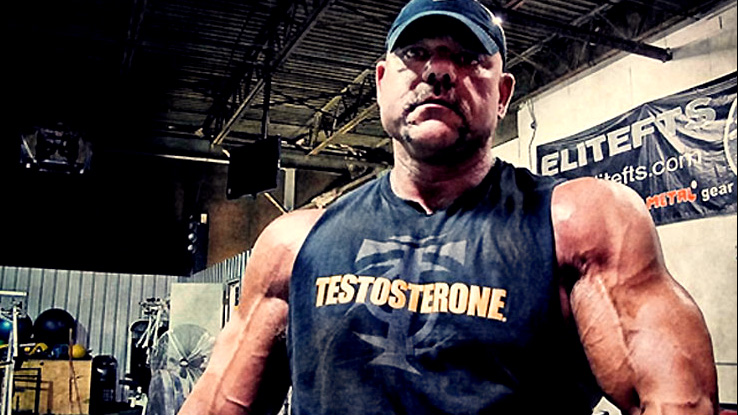The learning curve on the squat isn't steep so much as it's deep. In other words, the lower you go, the harder it gets.
There are a few reasons for this surge in difficulty. There are also a few reasons why you should be embracing it by squatting from the bottom-up yourself.
Gray Cook points out that, "A child does not learn to squat from the top down. In other words, he does not suddenly make a conscious decision one day to squat – he's squatting one day and makes the conscious decision to stand."
Stability Trumps Strength
When you squat from the bottom up, you have to find the right way to stack the weight you're carrying, whether it's your body weight alone or a heavy external load. While gravity can (and most definitely will) take us down from the top, you need to earn your way back up with stability.
Stability takes priority because strength can't be applied in its absence. When stability is outstripped by strength, problems begin to arise. It's like having a car with a powerful engine and cheap suspension. Up the output beyond a certain point and you'll wind up skidding off-course. Developing a squat from the bottom ensures that you have the stability to handle the toughest part of the movement.
And what makes the bottom part of a squat so tough? Beyond parallel, the quads and hamstrings are largely taken out of the equation. The core must create a base of stability for the glutes to help initiate movement. Only once back out of the hole can the majority of horsepower in the lower-body be made available. This becomes the limiting factor for anyone who wants to perform a full range of motion squat.
Stretch Shortening Cycle
There's also the very significant Stretch Shortening Cycle (SSC). This process relies on the elastic properties of muscle and fascia. When we follow a lengthening of the tissues with the contraction at just the right time, we're able to increase our output.
This is the heart of what's now known as plyometric training. Although Yuri Verkhoshansky, the father of plyometrics, would've referred to squatting as a preparatory plyometric (as it doesn't produce the level of speed or tension exhibited by other movements such as depth jumps), a quick eccentric (lowering) will still help facilitate a more powerful concentric movement.
There's a simple piece of reasoning that we'll have to agree on here: If you don't know what Point B looks like (or how far you have to travel), you're going to have a lot of trouble getting there from Point A.
This is no different for your squat than it is for plotting a route on a map. Granted, you won't wind up in Peoria if your squatting form is off, but you may wind up with some far graver issues.
Compensations
- Those with insufficient core strength to stabilize at the bottom of the squat may avoid the full range of motion, instead using the wrong muscles (and wrong sequencing) to stand back up.
- Those with asymmetries may rotate or shift laterally during the descent, putting undue pressure on the structures on one side of the body.
- Those with limited ankle or hip flexion, as well as those with limited thoracic extension, will generate too much flexion through the knees or lumbar spine.
- Those with poor stability through the lower-body may allow the knees to fall inward, putting tremendous stress on their medial structures.
- Those with poor movement patterning may perform the eccentric movement with insufficient hip flexion and excessive knee flexion.
- Those with poor core stability may hyperextend their lumbar spine, inhibiting the ability of the glutes to fire and negatively impacting stability.
- Those with a protective core musculature response (a CNS-based response to perceived injury risks) will inhibit motor control and proper movement sequencing, leading to any or all the above movement issues.
By reading the above examples, it's not hard to imagine why compensations are problematic. And that's if you're gently lowering yourself into position. Adding a ballistic drop will significantly magnify any mechanical imperfections.
Those with excessive mobility and insufficient stability might skip past creating stability with their soft tissues and bounce off of their bony approximations to come back up. Since this is the equivalent of punching yourself in the spine, I'm going to recommend against that, too.
For all of these reasons, we're going to eliminate the SSC until you have the strength and mobility to execute well from Point B.
The good news is that once your movement patterning is clean, you'll be able to reincorporate the SSC with better results, including improved acceleration from the bottom. This will help anyone performing squats with strict form.

What Does the Movement Look Like?
The simplest way to set up for bottom-up squats is to set the safety pins in a power rack at the bottom position. This is where you'll start.
You can spend as much time in the bottom position as you need to before bearing the complete weight of the bar. This is a big deal. It allows you the freedom to adjust in any way necessary to establish superb posture when you're still unloaded.
Once you're ready, you'll smoothly increase the amount of weight you're bearing by pressing up into the bar until you achieve liftoff. From here, you'll attempt to stand as explosively as possible.
There should be no apparent jumps or jerks as you stand – this is particularly important during the initial weight transfer. The entire point of this exercise is to strip your squat of movement inefficiencies and compensations. When the speed or intensity of loading outstrips your core strength, your spine will buckle (that's bad).
Lowering yourself back into position should be done with control since you'll have to be able to decelerate the weight effectively once you return to conventional squats.
That said, you'll notice that the position of the safety pins does allow you to take away much of the eccentric demands of the lift and to simply drop, which you may opt to experiment with.
Both of the above approaches are acceptable, although I'd recommend a more controlled lowering for those newer to squatting. If you're minimizing the eccentric component of this lift, make sure you're doing so intentionally, not because you're letting gravity have its filthy way with you.
Front or Back Squat?
I'm going to strongly recommend that you begin this process with the front squat. The reason being it's harder to mess up.
One of the most common squatting compensations is to tilt overly forward because of excessive knee or lumbar flexion. In this scenario, the back squat allows you to block the bar's forward roll with your back. In the front squat, however, you'd be punished for your indiscretions.
How Deep?
We're going to start this process below parallel (where the top of the hip drops below the knee). This degree of depth is very important. If you're using a power rack with larger gaps between settings for the safety pins, you may need to place a 45 lb. plate (or equivalent) under each foot to ensure the full range of motion.
If you're not able to get into this position with a neutral spine and your weight centered on your feet, then a loaded squat will not be your friend. Mobility work will have to come first.
How Heavy?
Our goal here is to work within the realm of strength-speed. This means something that takes some work to move but is light enough for you to feel the impact of acceleration. This generally means selecting 50-60% of your one-rep max. on the equivalent bottom-up squat variation. You'll perform this for 8-10 reps.
How Fast?
Since we need to eliminate the advantages of the SSC, you need to pause for two seconds at the bottom. This is enough time to allow the majority of stored elastic energy to dissipate and to reestablish posture. From there, you'll try to move as explosively as possible into the standing position.
Weight Chart
| Exercise | Weight | |||||
| Front squat (1RM) | 180 | 220 | 260 | 300 | 340 | 380 |
| Back squat (1RM) | 225 | 275 | 325 | 375 | 425 | 478 |
| BU front squat (8-10 reps) | 65-80 | 85-100 | 95-115 | 115-135 | 125-145 | 140-170 |
| BU back squat (8-10 reps) | 85-100 | 105-120 | 125-140 | 140-160 | 160-180 | 175-215 |
Bottoms Up!
It's easy to want to prioritize weight over movement quality. However, unless you're already rocking a pristine squat, it makes sense to return to the same type of motor learning that we're hardwired for as humans – namely squatting from the bottom up.
Consider taking a four-week period to really build a foundation of mobility and starting strength out of the hole. Odds are that this will help you accelerate the development of your squat and help you come out ahead in the long-term.
References
- Musculoskeletal interventions: techniques for therapeutic exercise By Michael L. Voight, Barbara J. Hoogenboom, William E. Prentice: 24, 2001
- Miletello, WM, Beam, JR, and Cooper, ZC. A biomechanical analysis of the squat between competitive collegiate, competitive high school, and novice powerlifters. J Strength Cond Res 23(5): 1611-1617, 2009
- Fear The Squat No More Part I by Paul Chek
- Siff, M and Y. Verkhoshanksky. SuperTraining. 2nd Edition. Pittsburgh: Sports Support Syndicate. 1996.
- Verkhoshanksy, Y. Are depth jumps useful? Yessis Rev. Sov. Phys. Ed. Sports 4: 75 – 78, 1968.
- Differences in squat jump and countermovement jump




